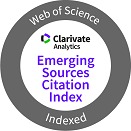Probabilistic forecasts of life expectancy for Rosario city, Argentina
DOI:
https://doi.org/10.35305/s.v9i2.256Palabras clave:
Functional data, Lee-Carter model, Forecast intervalResumen
Life expectancy at birth is one of the most useful indices for measuring the overall level of mortality and estimates the level of mortality more accurately than the crude mortality rate because it is independent of the age structure of the population. It also allows comparing the levels of mortality for different populations in different historical moments. Probabilistic forecasting models generate age-specific mortality rates for future period, and from these results, it is possible to derive forecasts of life expectancy at birth and their corresponding confidence intervals. In this paper two models are applied; the precursor of probabilistic models for mortality: the Lee and Carter model (1992) and the last one proposed in the area: the functional data model developed by Hyndman and Ullah (2008). Both models predict mortality, and enable, through life tables based on mortality forecasts, to derive life expectancy at birth. It is applied to mortality data of Rosario city, in the period 1980 to 2015, so as to obtain point and interval forecasts for life expectancy at birth.Citas
Alho, J. M. (2000). A statistical look at Modeen’s forecast of the population of Finland in1934. Yearbook of Population Research in Finland, 36, 107-120.
Andreozzi, L. & Blaconá, M. T. (2011). The Lee Carter method, for estimating and fore-casting mortality: an application for Argentina. Presented atthe ISF 2011 Prague - Proceedings. http://www.forecasters.org/submissions/>ANDREOZZILUCIAISF2011.pdf
Arriaga, E. (2014). Análisis demográfico de la mortalidad. Centro de investigaciones y estudios sobre Cultura y Sociedad. Córdoba, Argentina: CONICET & UNC.
Booth, H., Hyndman, R., Tickle, L., & de Jong, P. (2006). Lee-Carter mortality forecasting: a multi-country comparison of variants and extensions. Demographic Research, 15(9), 289-310.
Blaconá, M. T & Andreozzi, L. (2012). Comparación de métodos de estimación del modelo de Lee y Carter. Estadística, 64(182 y 183), 57-84.
García Guerrero, V. M. & Ordorica Mellado, M. (2012). Proyección estocástica de la mortalidad mexicana por medio del método de Lee-Carter. Estudios Demográficos y Urbanos, 27(2), 409-448.
Guerrero Guzmán, V. M. & González Pérez, C. (2007). Pronósticos estadísticos de mortalidad y su impacto sobre el sistema de pensiones de México. Prize-winningwork, Premio de Pensiones 2007 granted by Comisión Nacional del Sistema de Ahorro para el Retiro, 2007. http://www.consar.gob.mx/pre-mio_pensiones/premio_2007.shtml
Hyndman, R. J. with contributions of Booth, H., Tickle, L. & Maindonald, J. (2017). Demography: Forecasting Mortality, Fertility, Migration and Population Data. Rpackage version 1.19. https://CRAN.R-project.org/package=demography
Hyndman, R. & Ullah. H. (2007). Robust forecasting of mortality and fertility rates: A functional data approach. Computational Statistics and Data Analysis, 51, 4942-4956.
Hyndman, R. & Booth, H. (2008). Stochastic population forecast using functional data models formortality, fertility and migration. International Journal of Forecasting, 24, 323-342.
Hyndman, R., Booth, H. & Yasmeen, F. (2013). Coherent Mortality Forecasting: The Product-Ratio Method WithFunctional Time Series Models. Demography, 50(1), 261-283.
Kalben, B. (2000). Why men die younger. North American Actuarial Journal, 4(4), 83-111.
Lee, R. D. & Carter, L. (1992). Modeling and Forecasting the Time Series of U.S. Mortality. Journal of the American Statistical Association, 87, 659-671.
Lee, R. D. & R. Rofman(1994). Modelación y Proyección de la Mortalidad en Chile.Notas de Población, XXII, 59,182-213.
Lee, R. D. & Tuljapurkar, S. (1994). Stochastic population forecasts for the United States: Beyond high, medium, and low. Journal of the American Statistical Association, 89, 1175-1189.
Raftery, A. E. , Li ,N. , Sevˇc´ıkov´a, H. , Gerland, P. & Heilig, G. K. (2012). Bayesian probabilistic population projections for all countries. Proceedings of the National Academy of Sciences, 109,13915–13921
Ramsay, J. O. & Silverman, B. W. (2005). Functional data analysis. 2nd ed. New York, USA: Springer.
R Core Team (2014). R: A language and environment for statistical computing. Viena, Austria: R Foundation for Statistical Computing. http://www.R-project. org/
Serfaty, E., Foglia, L., Masautis, A. & Negri, G. (2007). Mortalidad por causas violentasen adolescentes y jóvenes de 10- 24 años. Revista Vertex, 40, 25-30.
Descargas
Publicado
Versiones
- 2021-12-30 (3)
- 2021-12-30 (2)
- 2017-12-30 (1)














